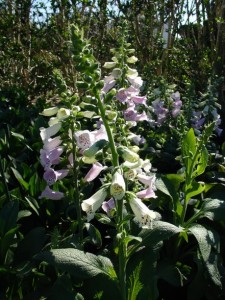 Professional gardeners know that creating continuous bloom in the mixed border can be challenging. The secret to having flowers in the garden straight through until frost is incorporating Annuals, Biennials and Tender Perennials.
Professional gardeners know that creating continuous bloom in the mixed border can be challenging. The secret to having flowers in the garden straight through until frost is incorporating Annuals, Biennials and Tender Perennials.
Annuals are those plants that grow, flower, set seed and die during a single growing season. Some of the best annuals for the back of the border are Cosmos ‘Sensation Mix’, Cleome ‘Queen Series’ and Verbena bonariensis. All of these plants grow quickly to more than 4′ and flower profusely into fall. The daisy-like flowers of Cosmos do require deadheading to look their best. If you want lower maintenance flowers, try Cleome or Verbena b. The wiry stems and purple flowers of Verbena b. blend well with nearly everything! TIP FOR SUCCESS: Because annuals must complete their life cycle in one season, they tend to be heavy feeders. Be sure to incorporate a time-release fertilizer formulated for flowering annuals into the soil when you plant them. And don’t be afraid to follow up with a liquid fertilizer, if necessary.
Biennials are plants that form a basal rosette of leaves during the first growing season. During the second season, they will flower, set seed and generally die. Hollyhocks (Alcea rosea), Foxglove (Digitalis purpurea), and Lupines (Lupinus) fall into this category. There are three ways to treat biennials. As short-lived perennials: Cutting the flower stalk down before seeds mature, will often help the plant survive for several years. As true biennials: Leaving the seeds to mature on the plant and fall to the ground will normally give you enough seedlings in the spring to fill the area. As annuals: The best way to guarantee a great show is to replace them every year with high-quality plants. TIP FOR SUCCESS: Biennials tend to flower in early to mid summer. If you don’t want a blank space in the garden when they finish flowering, be sure to plant mid-height perennials in front that flower later in summer like Phlox (Phlox paniculata) or Turtlehead (Chelone).
Tender Perennials are marginally hardy or short-lived perennial plants. Delphinium, Dahlias, Strawberry Foxglove (Digitalis mertonensis) and some tropicals fit into this category. TIP FOR SUCCESS: Marginally hardy plants like Dahlias and other tuberous plants can be dug up and stored in damp vermiculite over the winter and then replanted in early summer to avoid the possibility of freezing during winter. During mild winters, a heavy mulch might be enough to protect some tender plants. Some varieties are hardier than others, so experiment!
